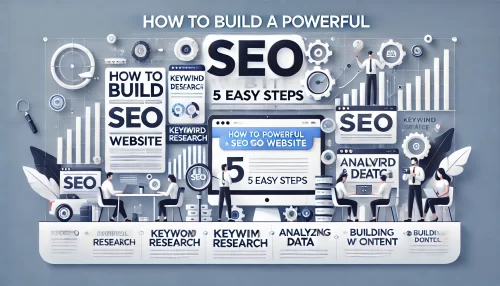How good is my website SEO? Are you leveraging your site’s full potential to drive organic traffic and boost search engine rankings?
This guide will answer your questions and provide actionable insights to evaluate and optimize your website’s SEO effectively.
What Does It Mean To Have Good Website SEO?
Good website SEO means your site is optimized to attract search engines and users effectively. This includes well-researched keywords, clean code, quality content, and excellent usability, all working together to boost rankings and engagement.
Key Elements Of A Strong Website SEO
A strong website SEO foundation includes optimizing on-page and off-page factors. On-page SEO ensures your content is user-friendly and keyword-rich, while off-page efforts like backlinks establish credibility. Prioritizing both builds a robust SEO strategy.
Technical SEO plays a big role too. Ensure your site loads quickly, is mobile-friendly, and has no broken links. Search engines reward sites that provide seamless navigation and excellent user experiences.
Don’t forget content quality. Google favors content that provides in-depth answers, reflects authority, and uses natural language. Invest in blog posts, landing pages, and multimedia content that resonate with your audience.
Lastly, an optimized URL structure matters. URLs that are clean, descriptive, and keyword-focused signal relevance to search engines, making your content easier to rank.
Importance Of SEO In Organic Traffic Growth
Organic traffic is a key metric for online success. SEO connects your website to people searching for your services or products, ensuring you reach your target audience without paid ads.
When your site ranks higher on Google, it attracts more clicks. People tend to trust organic results over paid promotions, making SEO-driven traffic more sustainable and cost-effective.
SEO also builds authority. Regularly publishing helpful, keyword-optimized content helps position your site as a trusted source. This fosters loyalty and drives repeat visitors.
Finally, SEO gives long-term results. While paid ads stop once the budget ends, strong SEO efforts continue delivering value, making them an essential investment.
How Search Engines Measure SEO Effectiveness
Search engines evaluate SEO using various metrics. One primary measure is relevance—does your content align with the user’s search intent? Keywords, titles, and meta descriptions must all work together to answer user queries.
Another key factor is website usability. Search engines track metrics like bounce rates and time-on-page to understand how engaging your site is. Engaged visitors often mean high-quality content.
Backlink quality also matters. Links from reputable, authoritative websites boost your site’s trustworthiness in the eyes of Google. However, avoid spammy links, as they can harm rankings.
Search engines emphasize mobile optimization. A mobile-friendly design ensures smooth browsing across devices, directly affecting your rankings and user satisfaction.
Tools To Instantly Check Website SEO Performance

SEO tools help you assess and improve your website’s SEO instantly. From identifying broken links to analyzing keyword usage, these tools provide actionable insights to optimize your site’s performance and rank higher.
Overview Of Popular Free SEO Tools
Free SEO tools are perfect for beginners and small businesses. Google Analytics is a must-have to track traffic sources, visitor behavior, and conversions. It gives clear data to refine your strategies.
Google Search Console is another essential tool. It identifies indexing issues, tracks keyword performance, and offers insights to improve visibility. Its actionable data makes SEO manageable for anyone.
Other tools like Ubersuggest and AnswerThePublic focus on keyword research. They help uncover search trends and long-tail keywords to align your content with user intent.
Each tool offers unique benefits, so combine them to cover all aspects of your site’s SEO performance. Regularly checking your metrics with these free resources can bring big improvements.
How To Use SEO Tools For Instant Results
Start by entering your site’s URL into tools like Google Search Console or SEMrush. These platforms immediately generate reports highlighting areas that need attention, such as low-performing pages or missing meta tags.
Keyword analysis is crucial. Tools like Ahrefs reveal which keywords drive traffic to your competitors. Use this data to target the right terms and improve your content strategy.
Use SEO tools to audit technical SEO. Identify issues like slow loading times or broken links, which can hurt your rankings. Tools like Sitechecker or Screaming Frog are particularly helpful here.
Set actionable goals based on your findings. For instance, if your bounce rate is high, focus on improving your content’s readability and relevance to keep visitors engaged.
Features To Look For In Paid SEO Tools
Paid SEO tools often come with advanced capabilities, such as competitor analysis, in-depth backlink audits, and keyword difficulty scoring. These features provide a competitive edge in optimizing your site.
Look for tools offering AI-driven insights. Platforms like Moz or SEMrush use AI to suggest personalized SEO improvements based on your specific site data. This can save time and effort.
Another valuable feature is content analysis. Tools like Clearscope or Surfer SEO analyze your competitors’ top-ranking pages and help you create more optimized, engaging content.
Prioritize tools with integration options. The ability to sync with analytics platforms or CMS systems ensures your SEO workflow remains seamless and efficient.
Steps To Evaluate How Good Is My Website SEO
Evaluating how good is your website SEO involves examining key factors that impact rankings, usability, and visibility. From analyzing keywords to ensuring technical stability, a thorough evaluation highlights strengths and areas for improvement in your SEO strategy.
Analyzing Keyword Placement And Density
Keyword placement directly impacts your website’s visibility. Search engines prioritize keywords in strategic locations such as titles, headings, meta descriptions, and the first 100 words of content. I suggest placing keywords naturally to keep your content user-friendly.
Maintaining an optimal keyword density prevents your site from being flagged for keyword stuffing. Tools like Yoast SEO or Rank Math can guide you in balancing the frequency of primary and secondary keywords while preserving content quality.
Remember, your keywords should serve the reader. Use them to address user intent, ensuring that each page delivers answers or solutions. I often recommend focusing on long-tail keywords to capture niche traffic.
Regularly reviewing and updating your keyword strategy ensures you stay aligned with shifting search trends. This proactive approach keeps your content competitive in dynamic markets.
Auditing On-Page And Off-Page SEO Elements
On-page SEO involves optimizing content, meta tags, images, and internal links. Start with a clear title, well-written meta description, and engaging headings. These elements not only improve SEO but also entice users to click.
Off-page SEO focuses on backlinks from reputable sites. I advise using tools like Ahrefs to assess your backlink profile and eliminate low-quality links that can harm your rankings. Building relationships with authoritative sites boosts credibility.
Ensure your content is visually appealing. Compress images for faster load times, add alt text, and use multimedia like videos or infographics to improve user engagement. These tweaks enhance both on-page SEO and user experience.
The synergy between on-page and off-page elements defines your overall SEO success. Pay equal attention to both for maximum impact on rankings and traffic.
Checking Mobile-Friendliness And Core Web Vitals
With mobile users dominating the web, having a mobile-friendly site isn’t optional—it’s essential. Use Google’s Mobile-Friendly Test to assess how your site performs on smartphones and tablets.
Core Web Vitals are also critical. Metrics like Largest Contentful Paint (LCP), First Input Delay (FID), and Cumulative Layout Shift (CLS) influence both user experience and rankings. I recommend tools like PageSpeed Insights to track these metrics.
Simple changes, such as responsive design, optimizing fonts, and ensuring tap-friendly buttons, make your site more mobile-friendly. These adjustments improve usability and show search engines you prioritize user satisfaction.
Consistency across devices matters. Ensure your site looks great and functions seamlessly, whether accessed on a desktop or a mobile device. This effort will positively impact your overall SEO performance.
Essential Metrics To Measure Website SEO Performance

Measuring the success of your SEO efforts requires tracking key metrics. These indicators reveal how your site performs in terms of visibility, user engagement, and authority, helping you refine your strategies for better outcomes.
Tracking Organic Traffic With Google Analytics
Kissmetrics is invaluable for understanding organic traffic trends. The platform shows you how many visitors reach your site via search engines, offering insight into your SEO effectiveness.
Analyze your most visited pages and their traffic sources. This data helps you identify high-performing content and replicate its success across other areas of your site. Focus on maintaining relevance and quality in your top pages.
Review bounce rates and session durations. High engagement metrics often indicate that your content matches user intent. Low performance may suggest a need for better targeting or improved content.
Set up conversion tracking to measure whether visitors are completing desired actions, like signing up or making a purchase. This helps you assess how well SEO contributes to your overall goals.
Understanding Domain Authority And Page Authority
Domain Authority (DA) and Page Authority (PA) predict how well your website or individual pages will rank. Tools like Moz or SEMrush can provide these scores, which are influenced by backlinks, content quality, and user experience.
Boosting DA and PA requires a steady flow of high-quality backlinks. I recommend focusing on natural link-building strategies, such as guest blogging or creating shareable, value-driven content.
Regularly monitor your scores to measure progress. A steady increase indicates that your SEO efforts are strengthening your site’s overall reputation and ability to compete in search rankings.
Remember, DA and PA are comparative metrics. Aim to surpass your competitors rather than achieving an arbitrary score, as this impacts your visibility in relevant search results.
The Role Of Bounce Rate And Dwell Time
Bounce rate measures how many visitors leave your site after viewing one page. High bounce rates often signal irrelevant content or poor user experience. I suggest optimizing readability and ensuring fast load times to keep visitors engaged.
Dwell time reflects how long users stay on a page. Content that captivates readers with value-packed insights naturally improves this metric. Use storytelling techniques and clear, concise writing to hold attention.
Strategically place internal links to encourage deeper exploration of your site. Visitors who navigate multiple pages spend more time on your site, which positively influences SEO.
These metrics are vital indicators of user satisfaction. Prioritize creating engaging, well-structured content that matches search intent to enhance both bounce rate and dwell time.
Common Website SEO Mistakes And How To Fix Them
Even well-optimized websites can fall victim to common SEO mistakes. Identifying and fixing these issues ensures your site remains competitive, user-friendly, and aligned with search engine best practices.
Issues With Duplicate Content And Thin Pages
Duplicate content confuses search engines, splitting ranking potential across multiple pages. Use canonical tags to point to the preferred version of duplicate content. I also recommend consolidating similar pages to improve focus.
Thin pages lack substance and fail to engage users. Address this by adding more valuable content, such as detailed guides, FAQs, or multimedia. I’ve seen websites significantly improve rankings with richer, more targeted content.
Check for duplicate or thin content regularly using tools like Screaming Frog. These audits help you maintain a strong content library that both users and search engines appreciate.
Consistently producing original, in-depth content reduces the risk of duplicate issues and helps establish your authority in your niche.
Optimizing URL Structures And Internal Links
A clear URL structure improves user experience and makes pages easier for search engines to index. Use descriptive, keyword-rich URLs to communicate content relevance at a glance.
Internal linking strengthens site navigation and spreads link equity. I advise linking related articles or pages strategically to guide users and improve site architecture.
Avoid overloading a single page with too many internal links. Instead, distribute them evenly to maintain a natural flow and avoid diluting SEO benefits.
These small adjustments can greatly enhance your site’s usability and SEO. Make optimizing URLs and internal links a regular part of your maintenance routine.
Resolving Crawl Errors And Indexing Problems
Crawl errors prevent search engines from accessing certain pages. Tools like Google Search Console help identify and fix these issues, ensuring your site remains fully accessible.
Broken links are a common cause of crawl errors. Regularly audit your site to find and repair these links, or redirect users to functioning pages to avoid losing traffic.
Indexing problems occur when pages aren’t properly listed on search engines. Submit updated sitemaps and check for “noindex” tags that may block essential content.
A well-maintained website allows search engines to fully understand and rank your content, which improves overall performance. I recommend making crawl audits a monthly priority.
How To Improve My Website SEO Fast

Improving website SEO quickly requires a strategic approach. Focus on key elements such as updating content, building high-quality backlinks, and leveraging local SEO tactics to drive meaningful traffic and improve rankings effectively.
Importance Of Regular Content Updates
Fresh content keeps your website relevant. Search engines prioritize updated pages, so I recommend revisiting old posts and refreshing them with new insights or data to maintain their value and appeal to readers.
Consistent updates also encourage users to return. Whether it’s a blog, landing page, or product description, ensuring your content remains accurate and aligned with trends boosts your credibility and engagement.
Content updates don’t always mean rewriting everything. Sometimes, adding a fresh paragraph, enhancing visuals, or linking to newer resources can do the trick. These small tweaks improve SEO performance over time.
Finally, consider a content calendar. Regularly planning and publishing new material ensures your site stays active, which signals to search engines that your website remains valuable and up-to-date.
Creating High-Quality Backlinks Strategically
Backlinks act as endorsements for your site, making them critical for SEO. Aim for quality over quantity; links from reputable sites carry more weight and authority in search engine rankings.
To build backlinks, I suggest creating shareable content such as guides, infographics, or expert interviews. These resources naturally attract links from other sites looking to reference credible information.
Guest blogging is another effective strategy. Partner with industry-relevant blogs to contribute insightful articles, ensuring your backlink appears naturally within the content. This approach benefits both traffic and reputation.
Avoid spammy or irrelevant backlinks. They can harm your site’s credibility. Regularly audit your backlink profile using tools like Ahrefs to maintain a clean and strong network of links.
Leveraging Local SEO For Geo-Targeted Traffic
Local SEO helps you connect with audiences in specific regions. Start by optimizing your Google My Business profile with accurate contact details, operating hours, and high-quality images to enhance visibility.
Incorporate local keywords into your content. For example, if you run a bakery in Chicago, phrases like “best Chicago bakery” help target nearby users searching for your services.
Encourage reviews from satisfied customers. Positive feedback on platforms like Google or Yelp not only builds trust but also improves local rankings, making it easier for nearby users to find you.
Local SEO doesn’t stop at keywords. Participating in community events or partnering with local influencers boosts your credibility and strengthens your connection to the area.
Advanced Techniques To Optimize Website SEO
Advanced SEO techniques elevate your site’s performance beyond basics. Implementing structured data, enhancing speed, and leveraging AI-powered tools can provide an edge in competitive markets.
Using Structured Data And Schema Markup
Structured data helps search engines better understand your content. For example, using schema markup can highlight events, recipes, or reviews, enabling rich results like star ratings or event dates in search listings.
I suggest tools like Google’s Structured Data Markup Helper to simplify the process. It provides step-by-step guidance to tag specific elements on your site for better visibility.
By adding structured data, your content becomes more relevant to users’ queries, boosting click-through rates. This often leads to better engagement and rankings, helping you stand out in crowded SERPs.
Regularly test your markup using the Rich Results Test tool to ensure it functions correctly. This minimizes errors and keeps your website eligible for enhanced search features.
Enhancing Page Speed And Server Response Times
Page speed impacts user experience and rankings. Slow-loading sites frustrate visitors and often lead to higher bounce rates. I recommend tools like GTmetrix or Google PageSpeed Insights to identify speed issues.
Compress images, enable browser caching, and use a Content Delivery Network (CDN) to reduce load times. These optimizations ensure your site remains fast and accessible, regardless of user location.
Consider upgrading to faster hosting services if your current provider limits performance. Reliable hosting improves server response times, which directly affects Core Web Vitals and SEO rankings.
A fast site isn’t just about performance—it reflects professionalism. Visitors are more likely to trust and engage with a website that delivers a seamless browsing experience.
Implementing AI-Powered SEO Tools
AI tools like Jasper, Surfer SEO, or Clearscope revolutionize optimization. They analyze vast datasets to provide insights on keyword placement, content structure, and competitive trends, saving time and effort.
AI can suggest ideal word counts, related terms, and readability improvements to align content with search engine algorithms. I’ve found these insights invaluable when crafting targeted, high-performing pages.
Automation features like AI-driven rank tracking and predictive analytics allow you to stay ahead of market trends. These tools help you adapt your strategy proactively, keeping your SEO efforts relevant.
While AI tools are powerful, remember to combine them with human creativity. Use the data they provide, but always prioritize connecting with your audience authentically.
How Good Is My Website SEO Compared To Competitors?

Understanding your SEO position against competitors helps refine your strategy. Analyzing their strengths and weaknesses reveals opportunities to enhance your site’s visibility and performance.
Conducting A Competitor Analysis For SEO Benchmarking
Start by identifying your top competitors. Use tools like SpyFu or Ahrefs to evaluate their domain authority, keyword rankings, and backlink profiles. This comparison highlights gaps you can address.
Pay attention to their content. Are they targeting specific keywords or producing unique types of content like videos or podcasts? Emulating their successes while adding your own twist gives you a competitive edge.
Track their technical SEO, such as page speed and mobile optimization. If they excel in these areas, prioritize similar improvements on your site to level the playing field.
Regular competitor analysis ensures your strategy remains dynamic and informed, helping you adapt to shifting industry trends effectively.
Finding Gaps In Content And Backlink Strategies
Examine competitors’ backlink sources to identify sites that might link to your content as well. Building relationships with these sites strengthens your backlink profile and domain authority.
Look for content gaps—topics your competitors haven’t covered. I recommend creating comprehensive guides or resources to fill these voids, positioning your site as a go-to resource.
Use tools like Content Gap Analysis to uncover keywords competitors rank for that you haven’t targeted. This insight helps you expand your keyword strategy and capture more traffic.
Targeting these gaps ensures your content stands out and addresses areas competitors have overlooked, giving your site a unique advantage.
Learning From Competitor SEO Successes
Study what works for your competitors. Analyze their high-performing pages and replicate the factors contributing to their success, such as keyword usage, format, or design.
Look into their user engagement metrics if available. Content with high shares or comments often resonates well with audiences, providing inspiration for your approach.
Competitor successes aren’t just about copying—they’re about learning. Identify why their strategies work, and adapt these lessons to create something uniquely valuable for your audience.
This approach helps you evolve while staying ahead in a constantly changing SEO landscape.
The Role Of SEO In Overall Digital Marketing Strategy
SEO integrates seamlessly with other marketing efforts. It complements paid ads, amplifies social media presence, and tracks ROI effectively, making it indispensable for achieving broader business goals.
Integrating SEO With Paid Advertising Campaigns
Combining SEO and paid ads increases visibility. Use SEO to target long-term rankings while ads generate immediate traffic. Together, they create a balanced strategy that drives both short-term results and long-term growth.
I suggest using retargeting ads for visitors who came through organic searches but didn’t convert. This keeps your brand top-of-mind and improves the chances of conversion.
Aligning keyword strategies between SEO and ads ensures consistency in messaging. This synergy improves your brand’s credibility and strengthens customer trust.
Using Social Media Signals To Boost SEO
Social media doesn’t directly impact rankings, but it increases content visibility. Sharing blog posts or resources on platforms like Twitter and LinkedIn encourages backlinks and traffic, indirectly benefiting SEO.
Encourage user interaction with your content. Comments, shares, and likes signal value to search engines, enhancing your site’s reputation and relevance.
Consistency is key. A strong social media presence amplifies your SEO efforts, creating a feedback loop that drives traffic and engagement across channels.
Tracking ROI From SEO Investments
Measure ROI from SEO by tracking metrics like organic traffic, conversions, and ranking improvements. These indicators show whether your efforts are delivering value and guide future investments.
Tools like Google Analytics or SEMrush provide clear data on performance. I recommend setting specific goals, such as lead generation or revenue growth, to assess the true impact of your SEO campaigns.
Focusing on measurable outcomes ensures your SEO strategy remains aligned with business objectives, maximizing both efficiency and effectiveness.






